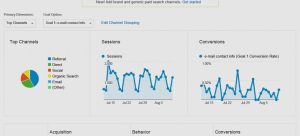Ever wondered why some links you click have long URLs?
These links are usually UTM-tagged for better recognition within Google Analytics, which helps you understand the behavior of your website visitors.
Analytics theory says that the most valuable visitors are those who come to your website by typing your URL directly in the browser or by choosing it from their Favorites/Bookmarks list. You can find their visit source in Google Analytics as Direct (none).
Even though, in my practice I have found that many visitors categorized as Direct actually came from some other source, usually a newsletter link which could be easily tracked but is now wasted.
Also, you know that your customers came from Facebook, but you don’t know which post made them purchase your product and which made them bookmark your webpage. Once you switch from Statistics (simply counting the number of visits, clicks, likes) to Analytics (finding the conversion source and improving it), you will find UTM tracking parameters very helpful and won’t imagine planning your campaigns without them.
If you aren’t familiar with Google Analytics campaign analysis concept, feel free to check all about it on Google Analytics website or contact our Traffic Team regarding any advanced Google Analytics implementation.
WHAT ARE UTM TAGS/TRACKING PARAMETERS
Urchin Tracking Modules – UTM tags or UTM tracking parameters are ways to properly categorize where your website visitors came from! When Google introduced Google Analytics, they also created the URL Builder Tool , which helps you tag your URLs properly. It allows you to add up to 5 arguments to your website URL, which will help you track that specific ad/post/article within Google Analytics.
Although people keep naming them as „tags“, these are actually arguments or parameters. My developer background doesn’t allow me to name them as „tags“, but that term became a common one, so I kept it here for better understanding.

5 URL BUILDER ARGUMENTS
1. Campaign Source (utm_source)
This tag is mandatory, it identifies where exactly did your ad appear. That can be a specific portal name, social network name or similar.
2. Campaign Medium (utm_medium)
Identifies the way your ad appears on the web page (banner, PR) but I suggest you use the Medium as you would use it within Google Analytics: Social, cpc, email, etc. This tag is also mandatory.
3. Campaign Term (utm_term)
This should be the keyword you use for identifying your ad. It will also appear as “keyword” within Google Analytics report.
4. Campaign Content (utm_content)
This tag is usually used for A/B testing, but it could be used for ad type, market, website language version or any other similar info that will help you distinguish one ad version from another.
5. Campaign Name (utm_campaign)
Surprisingly, that should be the name of your campaign .:) A group of your ads through various mediums (banners, newsletters, articles) that cover the same topic like “Autumn collection 2014” or “Early booking 2015”. This tag is also mandatory.
Most websites use UTM tags but our experience had shown us that many of them use them in the wrong way. You don’t have to be formal while tagging as long as you know where you will use them and where in Google Analytics you will find their data. You can play with terms and content the way you find it most useful, but take care of sources and mediums for better reporting.
Most users don’t tend to think globally and usually tag their ads/posts for one-time-only, thus making their Google Analytics reports complicated and nonreusable. Also, by creating your own Mediums, you will mess-up Google Analytics default channel grouping (although you can customize it) and you will not find your UTM-tagged Facebook posts under “Social” channel but under “Other”. And please, be aware of capital letters since if you put “Facebook” and “facebook” under utm_source, that would produce two separate “Source” entries in Google Analytics. Simply – use lowercase letters.
UTM CAMPAIGN CUSTOMIZATION EXAMPLES
1. Newsletter link
Always, always, al (wait for it!) ways use UTM tracking parameters in your newsletters! If you send them regularly, you can name each newsletter as an individual campaign, but you can also use them as a part of some global campaign too. Don’t forget to track each newsletter link separately in order to optimize it later!
UTM parameters can be:
&utm_medium=email&utm_source=Newsletter&utm_campaign=Autumn+Newsletter&utm_content=logo+link
&utm_medium=email&utm_source=Newsletter&utm_campaign=Autumn+Collection&utm_term=Shoes

2. Website banner
If you don’t tag your banner link, those visits will appear as Referrals, so you will not be able to determine which exact banner or article generated clicks. You can use Banner or Display for Medium, and some banner examples can be:
&utm_medium=display&utm_source=amazon.com&utm_campaign=Autumn+Collection&utm_term=Shoes
3. Social network posts
Same as the previous, if you don’t track your social links they will appear as Referrals (Medium), but thanks to the Google channel grouping they will also appear under Social channel. Still, you won’t be able to know which exact post brought you visits.
Therefore, try using URLs like:
&utm_medium=social&utm_source=facebook&utm_campaign=Autumn+Collection&utm_term=Shoes&utm_content=darkpost
&utm_medium=social&utm_source=twitter&utm_campaign=Autumn+Collection&utm_term=Shoes
Your employees probably share your Facebook posts among their friends. Once you prepare the link for all of them, you will know who is your most important influencer by using links such as:
&utm_medium=social&utm_source=facebook&utm_campaign=Autumn+Collection&utm_term=Shoes&utm_content=Employee+Name
4. Mail signatures
I’m sure you have a website link in your e-mail signature, but do you know which employee e-mail generates most visits and whose visits are most valuable? Probably not, because those links are not tagged, so they appear as Direct in your Google Analytics and are therefore wasted.
Here’s how you can track e-mail signatures for all your employees:
&utm_medium=email&utm_source=signature&utm_campaign=email+signature& utm_content=Employee+Name
But, if you write to someone about your “Autumn Collection”, don’t forget to put a website link in your e-mail body as:
&utm_medium=email&utm_source=email+body&utm_campaign=Autumn+Collection& utm_term=Shoes&utm_content=Employee+Name
5. QR codes
You know those odd codes that actually no one uses? Their creators usually put a plain website URL instead of using UTM tracking parameters, so they think that nobody uses them. If you track them properly, you will find they are used sometimes!
Use URL shorteners such as Bit.ly to shorten your UTM-tagged URL, otherwise, you will generate QR code that won’t be readable by most QR readers.
Some examples can be:
&utm_medium=qr&utm_source=citilighy&utm_campaign=Autumn+Collection&utm_term=Shoes
&utm_medium=qr&utm_source=Vogue&utm_campaign=Autumn+Collection&utm_term=Shoes&utm_content=full+size
Bonus: Printed ads!
You also advertise your website in paper or on billboards just by writing the website URL. Of course, what else? Wrong!
Try using URL shorteners or create domains like www.vogue.mywebsite.com that will make (301) redirect to URL like this:
&utm_medium=offline&utm_source=Vogue&utm_campaign=Autumn+Collection&utm_term=Shoes
Feel free to post your own cool examples in our comment section below. I would be very grateful to see some of our examples live or to use your suggestions in the future.




